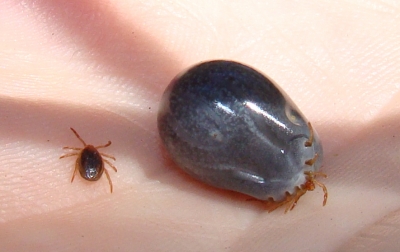Introduction to Paralysis Ticks
The Paralysis Tick (Ixodes holocyclus) injects a potentially fatal paralysing toxin when the female tick feeds off your pet. Ticks are commonly picked up in bushland or around waterways on the eastern coast of Australia. Native animals are not affected by paralysis ticks. Tick Paralysis is more common through the warmer, wetter months but can occur year-round.

The picture above demonstrates the change in size between an unengorged female tick compared to a fully engorged female tick.
Symptoms of Tick Parlysis
The tick toxin prevents nerves from activating muscles. This produces the “paralysis” that we see in affected pets. Once they start to become affected, pets can die from the toxin paralysing their breathing muscles if not treated.
The three major muscle groups the tick toxin paralyses are:
- Leg muscles: difficulty walking, wobbly or drunken gait, an inability to stand that gets worse over time;
- Chest muscles: difficulty breathing, increased breathing effort;
- Throat muscles: difficulty or inability to swallow, increased drooling, vomiting or regurgitating and an unusual sounding bark or meow.
Treatment
Treatment for tick paralysis involves the following:
- Sedative drugs, to keep your pet calm during their treatment. Tick paralysis patients are often much more stressed than normal which worsens their breathing.
- Premedication drugs such as atropine, to dry up saliva secretions and also reduce the risk of reaction to the tick antiserum.
- Placement of an intravenous catheter, to deliver the tick antiserum. Tick antiserum mops up tick toxin that has not already bound. Tick antiserum cannot remove toxin that has already attached to nerves. Your pet’s body will break it down in their own time. Tick antiserum does not provide immunity to further ticks.
- Every effort must be made to find all possible ticks as they will continue to intoxicate your pet whilst still attached. This is why a full body clip is necessary for all pets with hair longer than a Greyhound’s.

- A bath in an anti-tick solution to kill any ticks we cannot locate- becasue ticks are very small when they first attach, and may not be found before they cause further paralysis.
- Intravenous fluids – because your pet can’t eat or drink whilst their throat is paralysed and they cannot swallow properly.
- We intensively monitor your pet whilst they are hospitalised, this may include blood tests to monitor various factors such as their lung function, hydration status and electrolyte levels.
- We may need to provide oxygen therapy if your pet is having difficulty breathing (like the dog in the picture below).

- Aspiration pneumonia, caused by fluid from the stomach being regurgitated up and going into the lungs (if your pet can’t swallow) is one of the biggest complications of tick paralysis.
- Medications to prevent vomiting and regurgitation reduce the risk of them developing aspiration pneumonia but do not eliminate the risk completely.
- If your pet develops aspiration pneumonia then further medication and treatment will be required.
- Seriously affected patients sometimes require a ventilator machine to keep them breathing until their body can remove the tick toxin themselves.
- Pets can go home once they are able to eat properly, walk normally and urinate by themselves.
Tick antiserum is a blood product, which means allergic reactions can occur to the transfusion. Please notify us if your pet has ever had a blood transfusion, plasma transfusion, tick antiserum, or snake antivenom treatment before.
Outcomes
Tick paralysis manifests differently in each patient. Complications can develop quickly regardless of initial severity, even after the tick antiserum has been administered, and these can change both the treatment and the outcome.
Therefore, treatment can be unpredictable, possibly difficult and costs can escalate unexpectedly. Many cases are uncomplicated – they receive treatment, remain hospitalised for a short time and go home. The average stay in hospital for tick paralysis is 3 days.
However, other patients can develop complications such as pneumonia, and require days of intensive care. We consider every pet affected by a tick to be critical until they have fully recovered.

